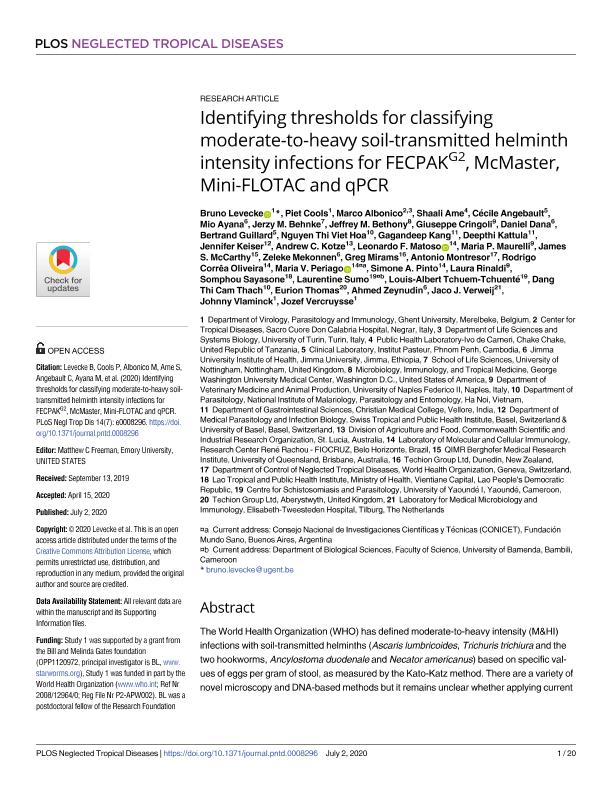Artículo
Identifying thresholds to classify moderate-to-heavy soil-transmitted helminth intensity infections for FECPAKG2, McMaster, Mini-FLOTAC and qPCR
Levecke, Bruno; Cools, Piet; Albonico, Marco; Ame, Shaali; Angebault, Cécile; Ayana, Mio; Behnke, Jerzy M.; Bethony, Jeffrey M.; Cringoli, Giuseppe; Dana, Daniel; Guillard, Bertrand; Viet Hoa, Nguyen Thi; Kang, Gagandeep; Kattula, Deepthi; Keiser, Jennifer; Kotze, Andrew C.; Matoso, Leonardo F.; Maurelli, Maria P.; McCarthy, James S.; Mekonnen, Zeleke; Mirams, Greg; Montresor, Antonio; Corrêa Oliveira, Rodrigo; Periago, Maria Victoria ; Pinto, Simone A.; Rinaldi, Laura; Sayasone, Somphou; Sumo, Laurentine; Tchuem Tchuenté, Louis Albert; Cam Thach, Dang Thi; Thomas, Eurion; Zeynudin, Ahmed; Verweij, Jaco J.; Vlaminck, Johnny; Vercruysse, Jozef
; Pinto, Simone A.; Rinaldi, Laura; Sayasone, Somphou; Sumo, Laurentine; Tchuem Tchuenté, Louis Albert; Cam Thach, Dang Thi; Thomas, Eurion; Zeynudin, Ahmed; Verweij, Jaco J.; Vlaminck, Johnny; Vercruysse, Jozef
 ; Pinto, Simone A.; Rinaldi, Laura; Sayasone, Somphou; Sumo, Laurentine; Tchuem Tchuenté, Louis Albert; Cam Thach, Dang Thi; Thomas, Eurion; Zeynudin, Ahmed; Verweij, Jaco J.; Vlaminck, Johnny; Vercruysse, Jozef
; Pinto, Simone A.; Rinaldi, Laura; Sayasone, Somphou; Sumo, Laurentine; Tchuem Tchuenté, Louis Albert; Cam Thach, Dang Thi; Thomas, Eurion; Zeynudin, Ahmed; Verweij, Jaco J.; Vlaminck, Johnny; Vercruysse, Jozef
Fecha de publicación:
07/2020
Editorial:
Public Library of Science
Revista:
Neglected Tropical Diseases
ISSN:
1935-2735
e-ISSN:
1935-2727
Idioma:
Inglés
Tipo de recurso:
Artículo publicado
Clasificación temática:
Resumen
World Health Organization (WHO) has defined moderate-to-heavy intensity (M&HI) infections with soil-transmitted helminths (Ascaris lumbricoides, Trichuris trichiura and the two hookworms, Ancylostoma duodenale and Necator americanus) based on specific values of eggs per gram of stool, as measured by the Kato-Katz method. There are a variety of novel microscopy and DNA-based methods but it remains unclear whether applying current WHO thresholds on to these methods allows for a reliable classification of M&HI infections. We evaluated both WHO and method-specific thresholds for classifying the M&HI infections for novel microscopic (FECPAKG2, McMaster and Mini-FLOTAC) and DNA-based (qPCR) diagnostic methods. For this, we determined method-specific thresholds that best classified M&HI infections (defined by Kato-Katz and WHO thresholds; reference method) in two multi-country drug efficacy studies. Subsequently, we verified whether applying these method-specific thresholds improved the agreement in classifying M&HI infections compared to the reference method. When we applied the WHO thresholds, the new microscopic methods mainly misclassified M&HI as low intensity, and to a lesser extent low intensity infection as M&HI. For FECPAKG2, applying the method-specific thresholds significantly improved the agreement for Ascaris (moderate → substantial), Trichuris and hookworms (fair → moderate). For Mini-FLOTAC, a significantly improved agreement was observed for hookworms only (fair → moderate). For the other STHs, the agreement was almost perfect and remained unchanged. For McMaster, the method-specific thresholds revealed a fair to a substantial agreement but did not significantly improve the agreement. For qPCR, the method-specific thresholds based on genome equivalents per ml of DNA moderately agreed with the reference method for hookworms and Trichuris infections. For Ascaris, there was a substantial agreement. We defined method-specific thresholds that improved the classification of M&HI infections. Validation studies are required before they can be recommended for general use in assessing M&HI infections in programmatic settings.
Palabras clave:
SOIL-TRANSMITTED HELMINTHS
,
INTENSITY
,
MCMASTER
,
QPCR
Archivos asociados
Licencia
Identificadores
Colecciones
Articulos(SEDE CENTRAL)
Articulos de SEDE CENTRAL
Articulos de SEDE CENTRAL
Citación
Levecke, Bruno; Cools, Piet; Albonico, Marco; Ame, Shaali; Angebault, Cécile; et al.; Identifying thresholds to classify moderate-to-heavy soil-transmitted helminth intensity infections for FECPAKG2, McMaster, Mini-FLOTAC and qPCR; Public Library of Science; Neglected Tropical Diseases; 14; 7; 7-2020; 1-20
Compartir
Altmétricas



